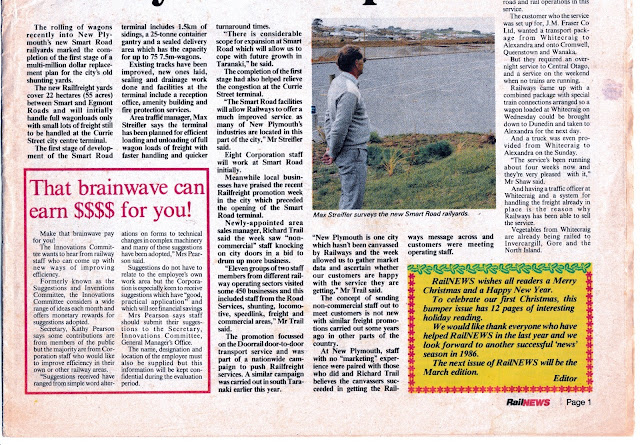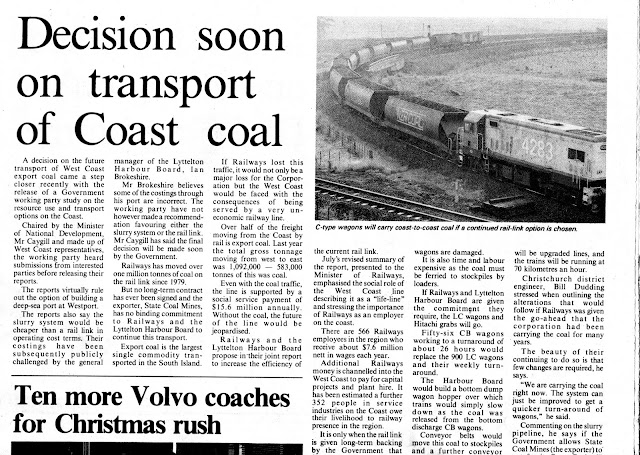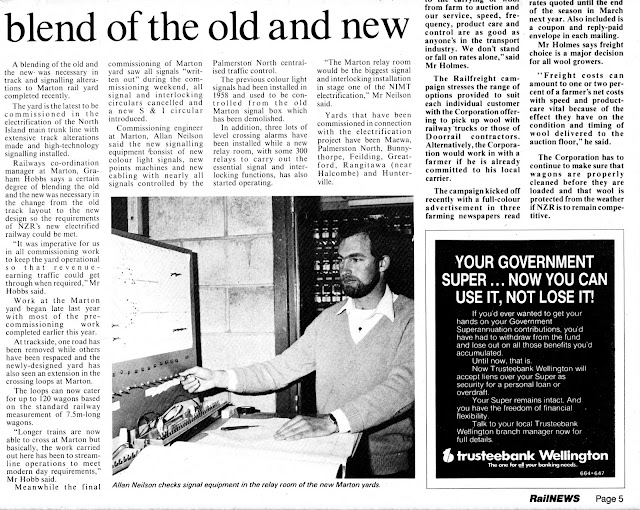This Christmas edition of RailNews (the in-house NZ Railways Corporation newspaper) was a "bumper issue" covering the ongoing process of restructuring, along with new investments and growth in traffic, as well as ample coverage of staff news. Some major points from this edition:
- $20m loss blamed on competition with road freight and the price freeze making it difficult for NZRC to respond. General Manager Gordon Purdy noted that forecasts that deregulation of land transport would see road operators focus on small lots and not long-haul bulk mainline freight was wrong, with road operators concentrating on long haul and bulk loads.
- New freight service from Whitecraig North Otago to Central Otago using rail and road for vegetables transported to Alexandra markets.
- Opening and development of Smart Road freight yards near New Plymouth. The yards were built at first to provide more capacity for freight and to service the growing commercial area to the east of New Plymouth. Subsequently, all of NZRC's New Plymouth freight operations would be relocated to Smart Road and the New Plymouth Railway Station and freight yard would be closed.
- Public consultation on proposed Sockburn-Styx deviation.. NZRC was opposed to the deviation, because it saw no net commercial benefit in the route. The Railways Department bought land for the route from the 1950s, it was intended to be a bypass of Christchurch for through traffic. NZRC preferred a direct northbound link at Addington from the south (which was ultimately built).
- New NZR Road Services passenger and parcels depot is under construction in Cromwell to replace the site to be flooded by the Clyde Dam.
- Construction of bogies for CA class coal wagons at Hillside Workshops.
- Decision soon on transport option for West Coast export coal. The choice was between rail and a slurry pipeline to offshore at Westport. There was concern if the slurry pipeline option was selected it would jeopardise the future of the Midland rail line. The report noted that 53% of freight shipped by tonnage on the line from the West Coast was coal. The line in 1985 received a subsidy of $15.6m. NZRC's proposal was to change the then coal operation . RailNews noted that at the time, 900 LC class wagons were used to transport coal from the West Coast with a five-six day turnover between Ngakawau and Lyttelton, and 10% of wagons are out of operation at any one time for repairs. They were to be replaced with 56 CB wagons with only a 26-hour turnaround. This was a significant improvement in productivity. Rail was eventually chosen for long-term export coal contracts and the subsidy was ended.
- Richard Prebble, Minister of Railways, opened a new Bulls Travel Centre and noting 10 new Volvo coaches would enter service by Christmas (1985).
- GM's Comment noting that if staff do not provide the service customers expect, business and jobs will be lost.
- DSJ shunting locomotives assembled at Addington Workshops with help from Japanese interpreters. Four shunters were assembled from Toshiba parts at Addington, with 40% NZ content.
- Success in NZRC marketing staff attracting new freight business in Otago, with a particular focus on new traffic in Central Otago.
- NZRC seeking to recapture wool traffic.
- Track and signal alterations at Marton to respond to NIMT electrification, including longer trains
- New publicity campaign at schools along the NIMT to teach safety around electrification
























No comments:
Post a Comment
Comments are gratefully received, but comments containing abuse or spam will be deleted